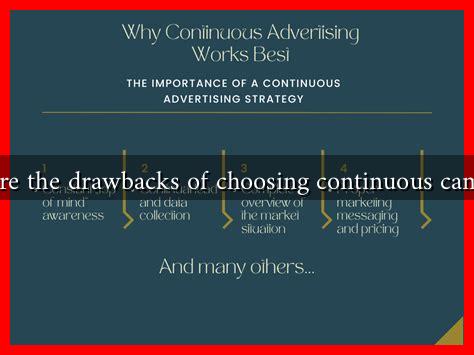-
Table of Contents
What are the Drawbacks of Choosing Continuous Campaigns?
In the world of marketing, continuous campaigns have gained popularity for their ability to maintain brand visibility and engagement over time. However, while they offer certain advantages, there are significant drawbacks that marketers must consider before committing to this strategy. This article explores the potential pitfalls of continuous campaigns, providing insights and examples to help businesses make informed decisions.
Understanding Continuous Campaigns
Continuous campaigns are marketing efforts that run indefinitely, often without a defined end date. They aim to keep a brand consistently in front of its audience, leveraging various channels such as social media, email, and digital advertising. While the intention is to build long-term relationships with customers, the execution can lead to several challenges.
Drawbacks of Continuous Campaigns
1. Resource Drain
One of the most significant drawbacks of continuous campaigns is the strain they can place on resources. Maintaining a constant flow of content and engagement requires substantial investment in time, money, and personnel.
- Financial Costs: Continuous campaigns often necessitate ongoing advertising spend, which can quickly add up. For instance, a brand that runs a perpetual social media ad may find its budget depleted faster than anticipated.
- Human Resources: A dedicated team is essential for managing and executing continuous campaigns. This can lead to burnout among staff, especially if they are tasked with producing high-quality content consistently.
2. Audience Fatigue
Another critical issue with continuous campaigns is the risk of audience fatigue. When consumers are exposed to the same messaging repeatedly, they may become desensitized or even annoyed.
- Decreased Engagement: Over time, the novelty of a campaign can wear off, leading to lower engagement rates. For example, a brand that continuously promotes the same product may see diminishing returns as customers lose interest.
- Negative Brand Perception: If a campaign becomes too repetitive, it can lead to a negative perception of the brand. Consumers may view the brand as desperate or out of touch with their needs.
3. Lack of Flexibility
Continuous campaigns can also hinder a brand’s ability to adapt to changing market conditions or consumer preferences. In a fast-paced digital landscape, flexibility is crucial for success.
- Inability to Pivot: If a campaign is set to run indefinitely, it may be challenging to pivot in response to new trends or competitor actions. For instance, a brand that is heavily invested in a continuous campaign may miss out on a viral trend that could have been leveraged for a more timely and relevant marketing effort.
- Stagnation: Continuous campaigns can lead to stagnation in creativity and innovation. Without the pressure of deadlines, teams may become complacent, resulting in uninspired content.
4. Measurement Challenges
Measuring the effectiveness of continuous campaigns can be complex. Unlike time-bound campaigns, which have clear start and end points, continuous campaigns may lack definitive metrics for success.
- Attribution Issues: It can be difficult to attribute sales or engagement directly to a continuous campaign, making it challenging to assess ROI accurately.
- Data Overload: Continuous campaigns generate a vast amount of data, which can overwhelm teams and make it difficult to extract actionable insights.
Case Studies and Examples
Several brands have experienced the drawbacks of continuous campaigns firsthand. For instance, a well-known beverage company launched a continuous social media campaign that initially garnered attention but eventually led to audience fatigue. Engagement rates dropped significantly after six months, prompting the brand to rethink its strategy.
On the other hand, brands that have successfully implemented time-bound campaigns often see better results. For example, a fashion retailer that runs seasonal promotions typically experiences spikes in sales and engagement, demonstrating the effectiveness of limited-time offers.
Conclusion
While continuous campaigns can provide ongoing visibility and engagement, they come with notable drawbacks that can hinder a brand’s success. From resource drain and audience fatigue to a lack of flexibility and measurement challenges, marketers must weigh these factors carefully. By considering the potential pitfalls and exploring alternative strategies, businesses can create more effective marketing campaigns that resonate with their audience and drive results.
For further reading on effective marketing strategies, consider exploring resources from HubSpot or MarketingProfs.

